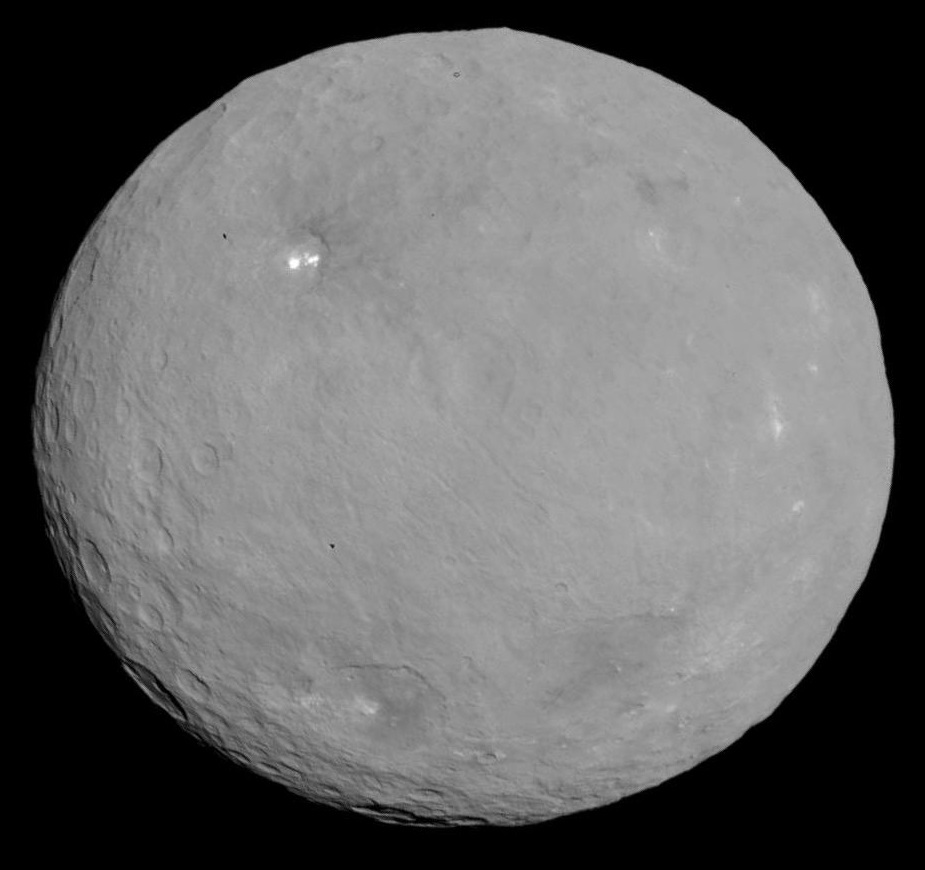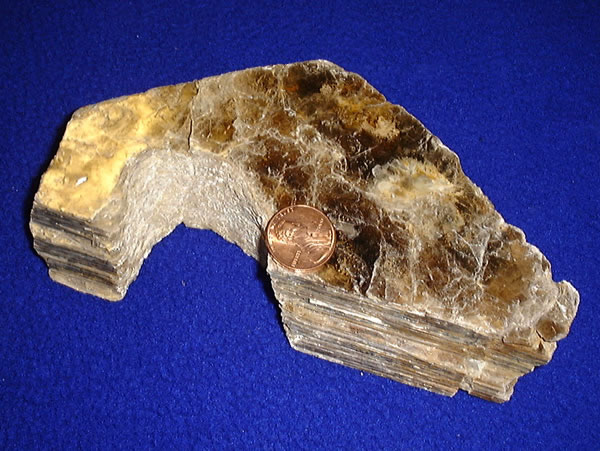|
G-type Asteroids (Tholen)
G-type asteroids are a relatively uncommon type of carbonaceous asteroid that makes up approximately 5% of asteroids. The most notable asteroid in this class is 1 Ceres. Characteristics Generally similar to the C-type objects, but contain a strong ultraviolet absorption feature below 0.5 μm. An absorption feature around 0.7 μm may also be present, which is indicative of phyllosilicate minerals such as clays or mica. In the SMASS classification the G-type corresponds to the Cgh and Cg types, depending on the presence or absence (respectively) of the absorption feature at 0.7 μm. The G-type, C-type and some rare types are sometimes collected together into a wider C-group of carbonaceous asteroids. See also * Asteroid spectral types An asteroid spectral type is assigned to asteroids based on their reflectance spectrum, color, and sometimes Astronomical albedo, albedo. These types are thought to correspond to an asteroid's surface composition. For small bodies that are not ... [...More Info...] [...Related Items...] OR: [Wikipedia] [Google] [Baidu] |
Carbon
Carbon () is a chemical element; it has chemical symbol, symbol C and atomic number 6. It is nonmetallic and tetravalence, tetravalent—meaning that its atoms are able to form up to four covalent bonds due to its valence shell exhibiting 4 electrons. It belongs to group 14 of the periodic table. Carbon makes up about 0.025 percent of Earth's crust. Three Isotopes of carbon, isotopes occur naturally, carbon-12, C and carbon-13, C being stable, while carbon-14, C is a radionuclide, decaying with a half-life of 5,700 years. Carbon is one of the timeline of chemical element discoveries#Pre-modern and early modern discoveries, few elements known since antiquity. Carbon is the 15th abundance of elements in Earth's crust, most abundant element in the Earth's crust, and the abundance of the chemical elements, fourth most abundant element in the universe by mass after hydrogen, helium, and oxygen. Carbon's abundance, its unique diversity of organic compounds, and its unusual abi ... [...More Info...] [...Related Items...] OR: [Wikipedia] [Google] [Baidu] |
Asteroid
An asteroid is a minor planet—an object larger than a meteoroid that is neither a planet nor an identified comet—that orbits within the Solar System#Inner Solar System, inner Solar System or is co-orbital with Jupiter (Trojan asteroids). Asteroids are rocky, metallic, or icy bodies with no atmosphere, and are broadly classified into C-type asteroid, C-type (carbonaceous), M-type asteroid, M-type (metallic), or S-type asteroid, S-type (silicaceous). The size and shape of asteroids vary significantly, ranging from small rubble piles under a kilometer across to Ceres (dwarf planet), Ceres, a dwarf planet almost 1000 km in diameter. A body is classified as a comet, not an asteroid, if it shows a coma (tail) when warmed by solar radiation, although recent observations suggest a continuum between these types of bodies. Of the roughly one million known asteroids, the greatest number are located between the orbits of Mars and Jupiter, approximately 2 to 4 astronomical unit, AU ... [...More Info...] [...Related Items...] OR: [Wikipedia] [Google] [Baidu] |
1 Ceres
Ceres ( minor-planet designation: 1 Ceres) is a dwarf planet in the middle main asteroid belt between the orbits of Mars and Jupiter. It was the first known asteroid, discovered on 1 January 1801 by Giuseppe Piazzi at Palermo Astronomical Observatory in Sicily, and announced as a new planet. Ceres was later classified as an asteroid and then a dwarf planet, the only one not beyond Neptune's orbit. Ceres's diameter is about a quarter that of the Moon. Its small size means that even at its brightest it is too dim to be seen by the naked eye, except under extremely dark skies. Its apparent magnitude ranges from 6.7 to 9.3, peaking at opposition (when it is closest to Earth) once every 15- to 16-month synodic period. As a result, its surface features are barely visible even with the most powerful telescopes, and little was known about it until the robotic NASA spacecraft ''Dawn'' approached Ceres for its orbital mission in 2015. ''Dawn'' found Ceres's surface to be a mixture ... [...More Info...] [...Related Items...] OR: [Wikipedia] [Google] [Baidu] |
C-type Asteroid
C-type (carbonaceous ) asteroids are the most common variety, forming around 75% of known asteroids. They are volatile-rich and distinguished by a very low albedo because their composition includes a large amount of carbon, in addition to rocks and minerals. They have an average density of about . They lie most often at the outer edge of the asteroid belt, from the Sun, where 80% of the asteroids are of this type, whereas only 40% of asteroids at from the Sun are C-type. The proportion of C-types may actually be greater than this, since C-types are much darker (and hence sampling bias, less detectable) than most other asteroid types, except for D-type asteroid, D-types and others that lie mostly at the extreme outer edge of the asteroid belt. Characteristics Asteroids of this class have spectrum, spectra very similar to those of carbonaceous chondrite meteorites (types CI and CM). The latter are very close in chemical composition to the Sun and the primitive solar nebula minus ... [...More Info...] [...Related Items...] OR: [Wikipedia] [Google] [Baidu] |
Ultraviolet
Ultraviolet radiation, also known as simply UV, is electromagnetic radiation of wavelengths of 10–400 nanometers, shorter than that of visible light, but longer than X-rays. UV radiation is present in sunlight and constitutes about 10% of the total electromagnetic radiation output from the Sun. It is also produced by electric arcs, Cherenkov radiation, and specialized lights, such as mercury-vapor lamps, tanning lamps, and black lights. The photons of ultraviolet have greater energy than those of visible light, from about 3.1 to 12 electron volts, around the minimum energy required to ionize atoms. Although long-wavelength ultraviolet is not considered an ionizing radiation because its photons lack sufficient energy, it can induce chemical reactions and cause many substances to glow or fluoresce. Many practical applications, including chemical and biological effects, are derived from the way that UV radiation can interact with organic molecules. The ... [...More Info...] [...Related Items...] OR: [Wikipedia] [Google] [Baidu] |
Phyllosilicate Mineral
Silicate minerals are rock-forming minerals made up of silicate groups. They are the largest and most important class of minerals and make up approximately 90 percent of Earth's crust. In mineralogy, the crystalline forms of silica (silicon dioxide, ) are usually considered to be tectosilicates, and they are classified as such in the Dana system (75.1). However, the Nickel-Strunz system classifies them as oxide minerals (4.DA). Silica is found in nature as the mineral quartz, and its polymorphs. On Earth, a wide variety of silicate minerals occur in an even wider range of combinations as a result of the processes that have been forming and re-working the crust for billions of years. These processes include partial melting, crystallization, fractionation, metamorphism, weathering, and diagenesis. Living organisms also contribute to this geologic cycle. For example, a type of plankton known as diatoms construct their exoskeletons ("frustules") from silica extracted from seawat ... [...More Info...] [...Related Items...] OR: [Wikipedia] [Google] [Baidu] |
Clay
Clay is a type of fine-grained natural soil material containing clay minerals (hydrous aluminium phyllosilicates, e.g. kaolinite, ). Most pure clay minerals are white or light-coloured, but natural clays show a variety of colours from impurities, such as a reddish or brownish colour from small amounts of iron oxide. Clays develop plasticity (physics), plasticity when wet but can be hardened through Pottery#Firing, firing. Clay is the longest-known ceramic material. Prehistoric humans discovered the useful properties of clay and used it for making pottery. Some of the earliest pottery shards have been radiocarbon dating, dated to around 14,000 BCE, and Clay tablet, clay tablets were the first known writing medium. Clay is used in many modern industrial processes, such as paper making, cement production, and chemical filtration, filtering. Between one-half and two-thirds of the world's population live or work in buildings made with clay, often baked into brick, as an essenti ... [...More Info...] [...Related Items...] OR: [Wikipedia] [Google] [Baidu] |
Mica
Micas ( ) are a group of silicate minerals whose outstanding physical characteristic is that individual mica crystals can easily be split into fragile elastic plates. This characteristic is described as ''perfect basal cleavage''. Mica is common in igneous and metamorphic rock and is occasionally found as small flakes in sedimentary rock. It is particularly prominent in many granites, pegmatites, and schists, and "books" (large individual crystals) of mica several feet across have been found in some pegmatites. Micas are used in products such as drywalls, paints, and fillers, especially in parts for automobiles, roofing, and in electronics. The mineral is used in cosmetics and food to add "shimmer" or "frost". Properties and structure The mica group comprises 37 phyllosilicate minerals. All crystallize in the monoclinic system, with a tendency towards pseudohexagonal crystals, and are similar in structure but vary in chemical composition. Micas are translucent to opa ... [...More Info...] [...Related Items...] OR: [Wikipedia] [Google] [Baidu] |
Asteroid Spectral Types
An asteroid spectral type is assigned to asteroids based on their reflectance spectrum, color, and sometimes Astronomical albedo, albedo. These types are thought to correspond to an asteroid's surface composition. For small bodies that are not planetary differentiation, internally differentiated, the surface and internal compositions are presumably similar, while large bodies such as Ceres (dwarf planet), Ceres and 4 Vesta, Vesta are known to have internal structure. Over the years, there has been a number of surveys that resulted in a set of different taxonomic systems such as the Tholen classification, Tholen, SMASS classification, SMASS and #Bus–DeMeo classification, Bus–DeMeo classifications. Taxonomic systems In 1975, astronomers Clark R. Chapman, David Morrison (astrophysicist), David Morrison, and Ben Zellner developed a simple taxonomic system for asteroids based on color, albedo, and spectral line, spectral shape. The three categories were labelled "C-type asteroi ... [...More Info...] [...Related Items...] OR: [Wikipedia] [Google] [Baidu] |
Asteroid Spectral Classes
An asteroid is a minor planet—an object larger than a meteoroid that is neither a planet nor an identified comet—that orbits within the inner Solar System or is co-orbital with Jupiter (Trojan asteroids). Asteroids are rocky, metallic, or icy bodies with no atmosphere, and are broadly classified into C-type (carbonaceous), M-type (metallic), or S-type (silicaceous). The size and shape of asteroids vary significantly, ranging from small rubble piles under a kilometer across to Ceres, a dwarf planet almost 1000 km in diameter. A body is classified as a comet, not an asteroid, if it shows a coma (tail) when warmed by solar radiation, although recent observations suggest a continuum between these types of bodies. Of the roughly one million known asteroids, the greatest number are located between the orbits of Mars and Jupiter, approximately 2 to 4 AU from the Sun, in a region known as the main asteroid belt. The total mass of all the asteroids combined is only 3% that ... [...More Info...] [...Related Items...] OR: [Wikipedia] [Google] [Baidu] |





